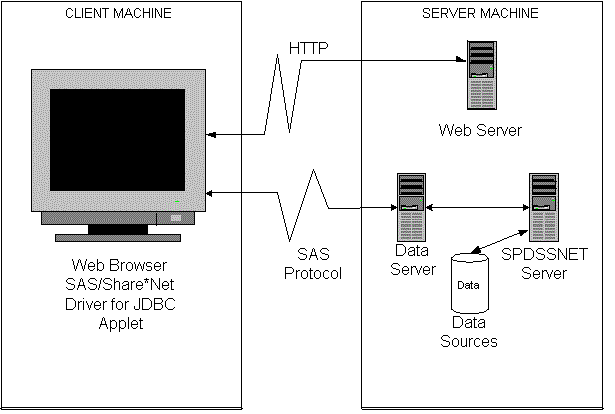Using JDBC (Java) to Access SPD Server Tables
Requirements and Considerations for Using JDBC
HTML File Requirement for JDBC
<applet code="CLASSPATH.*.class codebase="../ width=600 height=425> <param name=url value="jdbc:sharenet://spdssnet_node:PORT"> <param name="dbms_options" value=DBQ='LIBNAME' HOST='host_node' SERV='NNNN'> <param name="shareUser" value="userid"> <param name="sharePassword" value="thepassword"> <param name="shareRelease" value="V9"> <param name="dbms" value="spds"> </applet>
Limitations of Using JDBC with SPD Server
Example JDBC Query for Getting a List of Tables
The following example
shows JDBC used with SPD Server:
SELECT '' AS qual,
LIBNAME AS owner,
MEMNAME AS name,
MEMTYPE AS type,
MEMNAME AS remarks FROM dictionary.tables AS tbl
WHERE ( memtype = 'DATA' OR memtype = 'VIEW' OR memtype = 'SYSTEM TABLE' OR
memtype = 'ALIAS' OR memtype = 'SYNONYM')
AND (tbl.LIBNAME NE 'MAPS' AND tbl.LIBNAME NE 'SASUSER' AND tbl.LIBNAME NE 'SASHELP')
ORDER BY type, qual, owner, name
Example JDBC Query for Getting Metadata about a Specific Table
The following example
shows using JDBC to query your data file for metadata:
SELECT '' AS qual,
LIBNAME AS owner,
MEMNAME AS tname, name,
length AS datatype,
type || ' ',
length AS prec,length,
length AS scale, length AS radix, length AS nullable,label,
FORMAT FROM dictionary.columns AS tbl
WHERE memname = 'your data file'
AND (tbl.LIBNAME NE 'MAPS'
AND tbl.LIBNAME NE 'SASUSER'
AND tbl.LIBNAME NE 'SASHELP')
